|

photo - mw
_______________________
Review 'The Guy Davenport Reader'
Michael Robbins
Short version: Why are you reading this, when there’s a new Guy Davenport anthology?
Longer version: Guy Davenport died in 2005, a victim of chain-smoking, that most writerly of habits. The last piece of his I read before his death was a review of The Library of America edition of Ezra Pound’s “Poems and Translations,” which contains this passage:
Unfortunately, the Library of America text, which students will assume to be authoritative, displays the usual ineptitude with words in Greek. The tag from 'The Odyssey' so neatly tucked into 'Mauberley' has been set properly once, to my knowledge; here a hyperopic printer has seen an omicron with a soft-breathing above it as a delta. Polyphloisboio is misspelled on page 525. The Chinese characters are all set right side up; even so, a Chinese calligrapher might have been employed for an hour to graph them elegantly. What we have instead are Dorothy Pound's laborious tracings.
Of course no other reviewer noticed these errors. I read this casual display of preternatural erudition with astonishment, envy and something stronger than admiration — something like love — as I read almost every review or essay Davenport ever wrote. Who else could make poetry out of an erratum — "A hyperopic printer has seen an omicron with a soft-breathing above it as a delta"? (Actually, Paul Muldoon has done so.) Who else would so craftily note with approval the setting of Chinese characters right side up?
Davenport was not a writer's writer; he was the writer writer's writers read to learn their art. ...(more)
_______________________
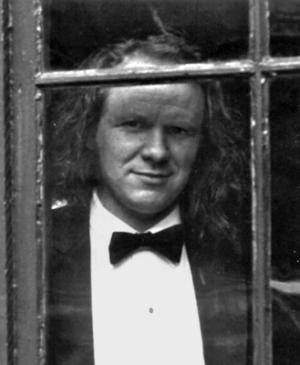
bpNichol
b. Sept. 30, 1944
bpNichol at Coach House Books
Toronto, ca. 1970
Letters to the World
bpNichol's poems celebrated the mutability of words
Jed Rasula
(....)
Allen Ginsberg's dictum "first thought, best thought" played havoc with aspiring poets of Nichol's generation, for whom "process" was a rallying cry and an invitation to indulgence. In one of his cartoons, Nichol depicts a gravestone's RIP and this clarifying caption: remains in process. "I wanted a writing . . . that would not pretend to an omniscience or to an authority that it didn't have," he recalled in a 1987 interview with Clint Burnham, reflecting back on his career, "a writing which partakes of the human condition in the sense that we're all vulnerable, we could die at any moment." Committed as he was to a process-oriented poetics (his long poem The Martyrology is a verse journal), Nichol nevertheless understood the sculptural demands of "immediacy." Amid even the most casual dictations, he manages to indicate, in an aside, that the words you're reading have been revised—or might be:
this next bit doesn't quite cohere
already past tense
or converted to a noun
when it's the bite of consciousness eludes you
Studied simplicity was an art of the '60s—think of Belmondo and McQueen—and Nichol, born in 1944, shares much with that generation muscled into consciousness in the grim postwar decade, only to have the world blossom before them like a Shangri-la accessible only to those under thirty. But even to put it this way is misleading, for Nichol's ecumenical outlook and transgenerational charity made him unique among his peers. He was a community builder, and his commune was the page, open to all. ...(more)
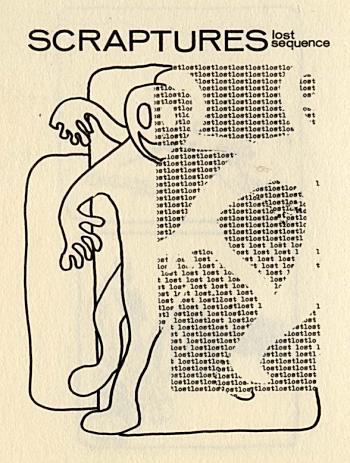
bpNichol
1 2 3
_______________________
This is translation not quite as autobiography, but maybe as “auto-graphy”: turning out my pockets, Schwitters-style, a bus ticket, a scrap of newspaper, a fag-packet, a page torn out of a diary. The words are not just words; they are words that I’ve knocked around with; they reflect my continuing engagement with Lowell, with Brodsky, with Bishop, with Malcolm Lowry; words that have had some wear and tear, there is fade in them, and softness, and history, maybe not visibly so for every reader, but palpably, to some.
Sharp Biscuit — Some Thoughts on Translating
Notes from a guilty business.
Michael Hofmann
(....)
Many, if not most translators, operate with an acquired language, or languages, and their own, which is the one, according to Christopher Logue, they have to be really good at. (I never trust people who translate both into and out of a language: isn’t there something unsanitary about that, like drinking the bathwater?) That brings a certain dispassion to their proceedings, a lab coat, tweezers, a fume cupboard. But both my languages are “my own”: German, my so-called mother tongue, and English, which I have no memory of learning at the age of four, and was the language I first read and wrote in. Both are lived languages, primal languages: the one of family and first namings, and now, of companionship and love; the other of decades of, I hope, undetectable and successful assimilation in England. Which should I be without?
I was happily bilingual till my mid-twenties, when I began, by economic necessity, to translate. The matching of my two languages is an inner process, the setting of a broken bone, a graft, the healing of a wound. Perhaps it can even be claimed that in me German is in some way an open wound, which is soothed and brought to healing by the application of English. Translation as a psychostatic necessity. Look, there is no break in my life, no loss of Eden, no loss of childhood certainties, no discontinuity, no breach, no rupture, no expulsion. English, then, as a bandage, a splint, a salve.
(....)
... A poem-translation can feel like the bundled-up corpse of an insect that’s got caught in a spider’s web, an overzealous parcel, attached by a thousand threads to the thing that will wait for it to die and then eat it: not a comfortable feeling, and not recommended. ...(more)
_______________________

Shipbuilding at Gloucester
(1871)
Winslow Homer
(February 24, 1836 – September 29, 1910)
_______________________
From "Words to the Wise"
(2 poems, 2009)
David Antin
Russian Proverbs
the wave betrays the wind
thirst teaches you the value of water
if you have nothing you’ve got nothing to lose
the squash calls the melon a cucumber
a small hole can sink a big ship
the road from the peak can only lead to the valley
its easier for a lake to become a swamp than for a swamp to become a lake
you can soften steel but it takes a lot of heat
experience may be a good teacher but its not a governess
when the river overflows, the last raindrop thinks it caused the flood
the sea swallows the wise as well as the fool
hope has distinguished relatives
if you’re looking for a lasting peace try a cemetery
...(more)
David Antin at EPC, the Poetry Foundation and PennSound
From “An Interview with David Antin, Spring 2013” conducted by Stephen Fredman [The full interview will appear as a foreword to David Antin's How Long Is the Present: Selected Talk Poems,
edited by Stephen Fredman and scheduled for publication by the University of New Mexico Press in 2014.]
presented by Jerome Rothenberg
(....)
For me poetry was and is the language art and within that arena I was trying to find a poetry of thinking, and I was criticized for an insufficiency of form. Back in 1973 Robert Kroetsch, the co-editor of Boundary 2 specifically objects to a lack of formal constraints in my talk poems, in somewhat the same way Robert Frost characterized free verse as trying to play tennis without a net. A few years later, I was scheduled to be on a panel for the MLA and on my way to the stage I bumped into Denise Levertov. We exchanged a few pleasantries and she asked me what I was there for. When I told her I was on the panel on contemporary poetry, she told me “But what you’re doing is not poetry at all.” A few years later Marjorie Perloff was giving a talk on a program with John Hollander and Harold Bloom at the Folger Library. Marjorie’s paper was on John Cage and me and she had barely begun when Bloom declared that we were not poets and stomped off the stage. I thought this was very funny because I thought all the furor was over. But then somewhat more recently Robert Pinsky, the Lugubrious Laureate, was so enraged at the Boston Review for publishing one of my talk poems that he tried to get the editor fired. I could easily multiply the number of these responses, but what’s the point?
(....)
... talking is the closest I can come to thinking. So maybe what you’re calling our volubility is a readiness for utterance that draws on a vast reservoir of thinking fed by ongoing conversations with oneself. This said, it still strikes me as strange that the great virtue of Creeley’s poetry is its terseness and ellipticality. It’s as if the free flow of his thinking--his volubility–-is subjected to severe criticism before it is released into the brilliant fragments of his poetry. In this context it’s interesting to compare him to Kenneth Rexroth, another very different voluble poet, whose fluent talking seems to emerge unchecked into his poetry from what must have been a relaxed internal conversation. And yet, I’m not sure how this addresses the experience of discovering while working, while walking or writing, something completely, almost unintelligibly, new.
...(more)
_______________________

photo - mw
_______________________
The In/Visibility of Peace:
Or "When Did You Last Go to See a Peace Movie?"
Jon Simons
Social Science Research Network
Abstract:
American liberal public culture finds it hard to imagine peace, as is evident in the idealized version of public culture in the TV series The Newsroom and was also the case in the hit musical Hair. There is a persistent gap between the pacific ideals of liberalism and its militaristic practices. Each time liberalism sees peace it cannot help but envision war too. In the founding text of liberal peace theory, Immanuel Kant’s “Perpetual Peace,” the distance between peace as a moral idea and empirical reality is not bridged, leading Kant to justify war against non-liberals who appear as a threat to the security of civil peace. Michael Doyle’s pioneering essay in contemporary liberal peace theory acutely analyzes the distance between liberalism’s internal pacifism and its external bellicosity, but covers it by reducing rational ideas to empirical hypotheses, overlooking the inherent antimony in Kant’s theory. In liberal peace studies, David Cortright repeats the split between empirical reality and moral commitment in Kant’s text, endorsing a version of realist pacifism that practices the policing and pacification of post-conflict societies and non-liberals. In critical peace and security studies (Mac Ginty, Richmond, Dillon, Reid, Shinko) such liberal peace-building is analyzed as a technocratic, disciplinary, biopolitical, governmental peace of the victor that confuses peace with order. While no peace that is not also war is unimaginable on the liberal horizon, a Foucauldian notion of agonistic peace envisions peace as the practice of freedom.
...(more)

photo - mw
_______________________
Notebook (Will Alexander, Lissa Wolsak, J. H. Prynne, &c.)
John Latta
Isola di Rifiuti
Three statements, a neap congeries for the boundless illimitable, the involuntary lingual reaches summoning the capacious world.
_______________________
Speculations IV
Politics and Speculative Realism [pdf]
Levi R. BRyant
A Very Dangerous Supplement: [pdf]
Speculative Realism, Academic Blogging, and the Future of Philosophy
Adam Kotsko
"The Horror of Darkness": Toward an Unhuman Phenomenology [pdf]
Dylan Trigg .....................................................
Continental philosophy in the pellucid register
Omnivore _______________________
from River Inside The River (a Lyric Sequence)
Gregory Orr
The Cortland Review
(....)
Note to self: remember
What Emerson said
Of Thoreau—
That he loved the low
In nature:
Muskrats
And crickets, suckers
And frogs.
Not stars.
Songs of the carnal,
Songs of what we are.
Not to lead us away
From the world
But deeper into it—
To persuade us
She is it.
Not all of it, not
Vastness,
But some one thing
We love—
Isn't that what he's become?
...(more)
Gregory Orr at the Poetry Foundation
Gathering the Poems Together: A Conversation with Gregory Orr
paris review
from Part One of
Concerning The Book That Is The Body Of The Beloved
Gregory Orr
poetry daily
From Concerning The Book That Is The Body Of The Beloved
Gregory Orr
drunken boat
_______________________

photo - mw
_______________________
Lemon Hound Turns One: A Prose & Narrative Folio
Bark, Bark! Lemon Hound turns one!
For our one-year anniversary we offer you a special Prose & Narrative folio. We do so to affirm our commitment to engaging in a wide swath of contemporary literature and signal our intention to publish the best, most exciting new voices. Our first ever folio includes excerpts from several books (en français comme en anglais), short stories, interviews and essays from very new to very established international writers. We recommit to creating a platform where we can begin to think through the history of prose writing, its new forms, its different backgrounds, just as we are committed to poetry, reviews, and the essay.
...(more)
_______________________
Solid, intangible
Bo Carpelan
Translated by David McDuff
Poems from Mot natten. Dikter 2010 ('Towards the night. Poems 2010', Schildts & Söderströms, 2013).
Books from Finland
Grilles
The houses climb around
but the streets have their chasms
children see with the backs of their heads.
From behind window grilles they see
the windswept trees,
black hands waving
motionless, blind.
If only they could open
all the closed and sleeping ones,
like a cut in a pumpkin
blood-red, with seeds
like stars. ...(more)
_______________________
The Letters of William Gaddis
reviewed by Jonathan Raban
(....)
One catches glimpses in the letters of the social life that Gaddis was leading in Manhattan when he wasn’t writing. It is surprising (at least it surprises me) to learn that this late high modernist, this fervent disciple of Eliot and Waugh, was not far from the center of another avant-garde, the Greenwich Village Beats. Jack Kerouac, William Burroughs, and Alan Ansen (a Harvard contemporary who’d spent a year as secretary to W.H. Auden) were close friends. Kerouac put Gaddis in The Subterraneans as Harold Sand (“a young novelist looking like Leslie Howard who’d just had a manuscript accepted and so acquired a strange grace in my eyes”). Gaddis spent the winter of 1953–1954 in Ansen’s Long Island house while Ansen was abroad. (“A house that is just the definition of a suburban house,” he told the Nappers. “But there is a vast and very select collexion of books, and a battery of records and machines to play them, and by now I’m almost mad enough to be at home only in an empty house….”)
...(more)
_______________________

photo - mw
_______________________
The State as a Virtual Object
[[or how Max Stirner can get you hanged]]
Rethinking Marxism 2013
Anarchist Without Content
(....)
Instead of saving Marxism and Anarchism, then, what may be called for is a renewed defense of two things: state phobia and non-empiricism. My defense of state phobia is political. While governmentality studies describe power well, they lack external grounds for critiquing that power. A study of governmentality can of course analyze power according to its own self-professed aims, but without something like Derridean deconstruction or Adornian immanent critique, the study is not political but descriptive. ...(more)
via Attempts at Living
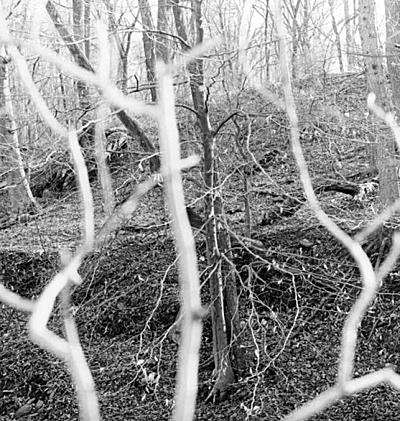
Virginia
1988
from the series Earthly Delights
Ray K. Metzker
Laurenc Miller Gallery
“The Last Great Modern Photographer”
Judith B. Herman on Metzker
_______________________
'We’re British - There’s No Cure For That': An Interview with Lars Iyer
by Marc Farrant
Review 31
(....)
W. and Lars, the central characters in the Spurious trilogy, are fascinated with the literature and philosophy of what they call ‘Old Europe’. Much of the comedy of the trilogy follows from the distance between ‘Old Europe’ and the contemporary Britain of the characters. There is something ridiculous about the importance W. and Lars give to their own endeavours, which is patterned after the writers and thinkers they admire, in a world completely indifferent to their concerns. But I hope there is something admirable about W. and Lars, too – something that moves the reader in the characters’ vehement attempts to think in the tradition of their masters. The plight of W. and Lars is derisory but also, perhaps, inspiring. More broadly, my characters’ predicament is a way of marking the problem of the contemporary novel in my novels. How ridiculous to try to do something new in a British novel today! The task becomes one of evidencing that ridiculousness, that sense of imposture. I seek to do so laughingly, lightly, remembering what Chesterton said: ‘solemnity flows out of men naturally; but laughter is a leap. It is easy to be heavy: hard to be light’. Here, Vila-Matas, Bolaño and Bernhard are inspirations, fellow travellers. They understand the situation we’re in.
(....)
W. claims that Lars is engaged in all kinds of activities for which the prefix ‘non-’ is relevant. W. claims Lars is a ‘non-dancer’, that he is ‘non-religious’, by which he means that Lars renders chaotic – wild - the usual forms of dancing and religion; that Lars disturbs the usual ‘economy’ that organises these practices. The same holds for Lars’s supposed ‘non-writing’. My trilogy is narrated by a fictional ‘Lars’. W. links Lars’s blog directly to chaos; Lars, for W., writes a kind of ‘non-writing’. If we take W. seriously on this point, the novels themselves might be understood to have an important relation to ‘non-writing’, perhaps to ‘non-literature’. The novels themselves cannot simply be chaos – they can’t incarnate or realise non-literature, as it were, since literary works of any kind always depend on a certain order – on grammar, word-meanings and so on. But the novels can attest to chaos in some sense; they can welcome and even affirm it. This affirmation, such as it is, might be understood to be enacted in my novels through a wild kind of humour –a black comedy that also laughs at the conventions of literary fiction.
Of course, there is a whole tradition, or counter-tradition, of blackly humorous, unconventionally-structured novels at the edges of the literary tradition. Thumbing your nose at the conventions of the novel is very much part of the tradition of the novel. But the strength of a counter-tradition depends on the prestige of the tradition it apes. And when this prestige has come to wane.... ‘We have no great literature’, Krasznahorkai says in a recent interview. ‘But readers need [his novel Satantango], not as medicine, not as delusion, because they need someone to tell them there is no medicine’. I would love to say the same of my novels: readers need them to tell them that the time for literary novels is over.
(....)
‘Chaos’ and ‘non-writing’, as I have called them, might be understood to operate in a manner analogous to what Blanchot calls variously ‘worklessness’, ‘the impossible’, ‘the outside’, ‘the narrative voice’, ‘saying’, etc. In both his literary-critical and fictional writings, Blanchot seeks to bear witness to a kind of chaos with which, he argues, art and literature are engaged. For Derrida, too, literature names something unsettling and strange, functioning in his work, he says, ‘as an allusion to certain movements which have worked around the limits of our logical concepts, certain texts which make the limits of our language tremble, exposing them as divisible and questionable’. For Derrida, as for Blanchot (and we could mention Foucault and Deleuze here, Nancy and Agamben, indeed a whole bunch of thinkers of the ‘outside’), literature threatens our sense of presence, of identity, and of a cluster of related terms used by philosophers.
...(more)
Spurious
Wittgenstein Jr.
_______________________
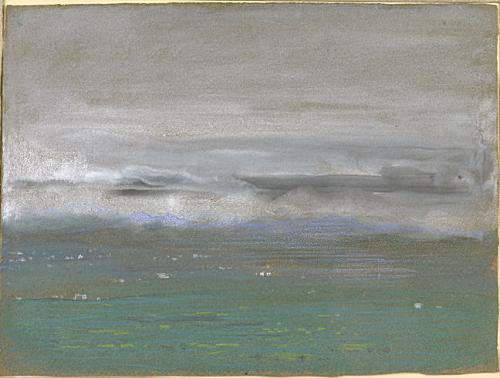
Enveloped Mountains
ca. 1915
Arthur Bowen Davies
b. Sept. 26, 1863
_______________________
special issue on Julia Kristeva
Journal of French and Francophone Philosophy
Vol 21, No 1 (2013)
Julia Kristeva and the Politics of Life
Sarah K. Hansen
Abstract
In her recent writings on the powers and limits of psychoanalysis, Julia Kristeva develops a theory of power and subjectivity that engages implicitly, if not explicitly, with biopolitical themes. Exploring these engagements, this paper draws on Kristeva to discuss the mute symptoms of homo sacer and the regulatory power of the spectacle. Staging an uncommon (and sometimes antagonistic) conversation between Kristeva, Agamben, and Foucault, I construct a field of inquiry that I term the “psychic life of biopolitics.”
Julia Kristeva's Voyage in the Thérèsian Continent:
The Malady of Love and the Enigma of an Incarnated, Shareable, Smiling Imaginary
Maria Margaroni
Abstract
Drawing on Julia Kristeva's amorous dialogue with Therese in Therese, mon amour, her third volume on the powers and limits of psychoanalysis (La haine et le pardon), and Cet incroyable besoin de croire, my aim in this essay is to unpack Kristeva's theory of sublimation which, I suggest, Therese helps her elaborate, enrich and complicate. In particular, I focus on Kristeva's foregrounding of the mediating role of language in the sublimatory process and her rethinking of the experience and stakes of sublimation in light of what has been discussed as the central problematic of the baroque: namely, the blurring of the distinction between appearance and reality and the uninhibited celebration of illusion. As I demonstrate, this problematic and Therese's unique response to it are most important for Kristeva since they enable her to raise questions which carry her beyond her previous treatments of sublimation. These questions relate to the amorous source of the imaginary; the dynamic established between idealization and sublimation; the dangers of an unbridled imaginary; the uncomfortable residue of matter and the body; the dialectic between finitude and infinity, unity and multiplicity.
Keeping it Intimate: A Meditation on the Power of Horror
Sara Beardsworth
Abstract
The paper is a reading of Julia Kristeva, The Severed Head. It first interprets a dual historical element in Kristeva's text on "capital visions," her selection of exemplars of the artistic representation of severed heads. On the one hand, there are the aesthetic trajectories themselves, from skull art to artistic modernism. On the other hand, there is an implicit history of "horror" in psychoanalysis in this text, going from Freud through Lacan to Kristeva. The paper then indicates the tone of possibility and invitation that inhabits Kristeva’s treatment of horror in capital visions, which suggests that she does not divide aesthetics off from ethics. Finally, I underline the note of humor that enters into the psychoanalytic and aesthetic treatment of horror, once Kristeva has linked it to the feminine.
more
_______________________

photo - mw
_______________________
Translation 2.0
Eric Zboya’s At the Heart of a Shipwreck
Gary Barwin
jacket2
At the Heart of a Shipwreck
1.
Birdlike, a poem lifts off from the page, leaves words behind, ascends beyond ink.
But then it flies into a window.
For a moment: feathers, flight, song and nascent inside-egg become two dimensional as the bird writhes and attempts to rise against the glass.
A birdwreck from the dimensionless air.
And we readers watch, as readers always do, from the other side.
The poem’s inky body has struck the—until then—invisible surface, has written a record of its flight.
2.
Eric Zboya’s At the Heart of a Shipwreck is a “translation or transformation” of Mallarmé’s typographically inventive poem “Un coup de dés” (A throw of the dice.)
Translation is the thing with feathers. A hummingbird ascending a staircase of air. The Icarus-like energy of language as it struggles against the bright sun of the page. The filigree of water as angels cannonball into the sea. Breath ascending from the heart of a shipwreck to the surface of the page.
How are the words, the lines, the meaning of the original Mallarmé turned into the no-longer French flaps of these beating inkwing traces?
...(more)
_______________________

photo - mw
_______________________
A certain thought refuses to leave my mind in peace: We are, hollow; we inhabit and are inhabited by echoes. We are made of words and make our echoic inner worlds—“my” world, “your” world. But we are hollow.
—
Virginia Woolf, from Selected Diaries
via Forgottenness
_______________________
"Prisons We Choose to Live Inside"
The 1985 CBC Massey Lectures
Doris Lessing
_______________________
Bleeding Edge by Thomas Pynchon: Dotcom survivors
A book where even the phrase "You are so grounded" takes on significance.
Leo Robson
One of the things that Pynchon wants to expose is the way we massage things into metaphor and then forget that we’ve done it.
_______________________
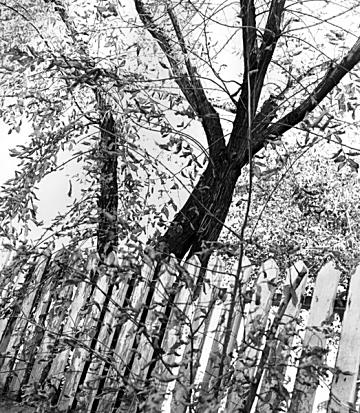
Denver
1986
Ray K. Metzker
Laurenc Miller Gallery

Jirí Kolár
1970
_______________________
... there are readers and there are readers. There are people who read to anesthetize themselves—they read to induce a vivid, continuous, and risk-free daydream. They read for the same reason that people grab a glass of chardonnay—to put a light buzz on. The English major reads because, as rich as the one life he has may be, one life is not enough. He reads not to see the world through the eyes of other people but effectively to become other people. What is it like to be John Milton, Jane Austen, Chinua Achebe? What is it like to be them at their best, at the top of their games?
English majors want the joy of seeing the world through the eyes of people who—let us admit it—are more sensitive, more articulate, shrewder, sharper, more alive than they themselves are. The experience of merging minds and hearts with Proust or James or Austen makes you see that there is more to the world than you had ever imagined. You see that life is bigger, sweeter, more tragic and intense—more alive with meaning than you had thought.Real reading is reincarnation.
Mark Edmundson, The Ideal English Major
_______________________
phenomenology never goes out of date
Susanna Siegel interviewed by Richard Marshall
3am
Susanna Siegel is the major philosophical mentalist who gets into our heads and deep into the depths of philosophical phenomenology, epistemic downgrades, how the issues can be approached from different traditions, considers a gun in a fridge, how priming examples don’t reveal underlying psychological mechanisms, cognitive modularity and what it does and doesn’t insulate, top-down effects, the rational accessibility of perception, the contents of visual experience, the richness of perception and what to do about sexism in professional philosophy. Off we go.
(....)
Where I went to college, ‘analytic philosophy’ was a class you could take, rather than the mode of philosophy that was taught. In that milieu, the authors that spoke to me the loudest were Marx, Freud, and Kant. I was drawn to the way they would describe social or psychological phenomena from the outside, diagnosing our experiences of normality as an artifact of structures whose influence on us operates under the radar. In some way, understanding the epistemic problem of top-down effects on perception is similar to what in other disciplines is called ‘ideology critique’. You uncover the hidden etiology of what happens – not just in perceptual experience, but in the mind more generally, and in History. And all of these cases raise the same normative questions.
(....)
We need a theory of the cognitive underpinnings of implicit bias, together with a theory of the kind of state the prime puts people in. We also need to understand better how social interacts effect perception. For the most part, work in social psychology and in vision science have proceeded independently. But partly in response to experiments like Payne’s, as well as work on racial categories and face perception, that division has started to loosen.
(....)
My framework is for understanding the epistemic implications of a range of top- down effects. It is useful to map out the different types of potential top-down effects on perception, so that we can assess their epistemic consequences. There is a theoretical dimension to every experimental science. Starting with data that have been collected, one has to generate hypotheses about specific data. Since the existence of cognitive penetration is unclear, this kind of theorizing is needed. Starting from other direction, one can also generate models of different types of top-down effects, and then see what sorts of data these models are compatible with. This kind of theorizing is useful for epistemology, since general epistemic issue isn’t targeted at cognitive penetration per se. You might call either kind of theorizing “ a priori psychology”, but that label is a bit misleading. It suggests that one is purporting to know facts about actual psychological processing from the armchair. And it also suggests that we’re not drawing on other empirical facts when we generate those hypotheses. A better term would be ‘theoretical psychology’.
...(more)
_______________________
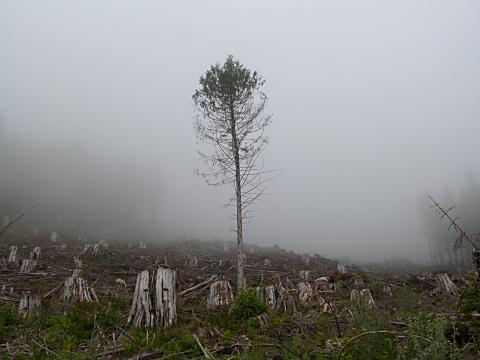
Clear cut at Chehalis Lake
.Photo by Sharon Kravitz
from Your BC: The Tyee's Photo Pool
_______________________
Clearcut
Amanda Jernigan
It pleases us to think the sun
redeems the logging roads with cane,
with high cicadan orisons,
with fern and black-eyed Susan.
Picking our way amid the slash
we say blackberry rosaries,
we finger their knotted beadwork, one
for the bucket one for me,
as in he loves me not he loves me.
Watching where we eat our prayers
the trees themselves might pity us.
When autumn comes they lose their leaves
by accident, deciduous.
From All the Daylight Hours (Cormorant, 2013) by Amanda Jernigan.
the véhicule press blog
via The Page
Amanda Jernigan at the Poetry Foundation
Five poems from GroundworkAmanda Jernigan Numéro Cinq » A warm place on a cruel web
Amanda Jernigan On Beautylemon hound
_______________________

photo - mw
_______________________
Dollarocracy
John Nichols and Robert W. McChesney
The Nation
(....)
With the underpinnings of civil society under assault, it is easy and often necessary to be drawn into the fight of the moment, to battle as teachers in Wisconsin and women in Texas and African-Americans in North Carolina have to preserve gains once thought to be permanently enshrined. Those battles are vital and cannot be neglected. But they are not enough. Merely responding to the constantly emerging symptoms of the crisis or waiting in hopes of a better election result or the next Supreme Court appointment simply locks in a “new normal” that is certainly not new and should never be normal.
(....)
When progressives wrap their heads around the idea of fundamental change, the range of possibility expands. The demand moves beyond the technical to the aspirational. We don’t suggest that it’s easy to amend the Constitution or to reshape political or media systems. And it may really be impossible to win some fights. But any honest assessment of America’s arc of history tells us that it has bent toward justice only when the demand has been sufficient to address the crisis.
...(more)
_______________________
Pedagogy of the Oppressed
Paulo Freire
translated by Myra Bergman Ramos
google books
The central problem is this: How can the oppressed, as divided, unauthentic beings, participate in developing the pedagogy of their liberation? Only as they discover themselves to be “hosts” of the oppressor can they contribute to the midwifery of their liberating pedagogy. As long as they live in the duality in which to be is to be like, and to be like is to be like the oppressor, this contribution is impossible. The pedagogy of the oppressed is an instrument for their critical discovery that both they and their oppressors are manifestations of dehumanization.
Liberation is thus a childbirth, and a painful one. The man or woman who emerges is a new person, viable only as the oppressor-oppressed contradiction is superseded by the humanization of all people. Or to put it another way the solution of this contradiction is born in the labor which brings into the world this new being: no longer oppressor nor longer oppressed, but human in the process of achieving freedom.
This solution cannot be achieved in idealistic terms. In order for the oppressed to be able to wage the struggle for their liberation they must perceive the reality of oppression not as a closed world from which there is no exit, but as a limiting situation which they can transform. This perception is a necessary but not a sufficient condition for liberation; it must become the motivating force for liberating action. Nor does the discovery by the oppressed that they exist in dialectical relationship to the oppressor, as his antithesis that without them the oppressor could not exist — in itself constitute liberation. The oppressed can overcome the contradiction in which they are caught only when this perception enlists them in the struggle to free themselves.
_______________________
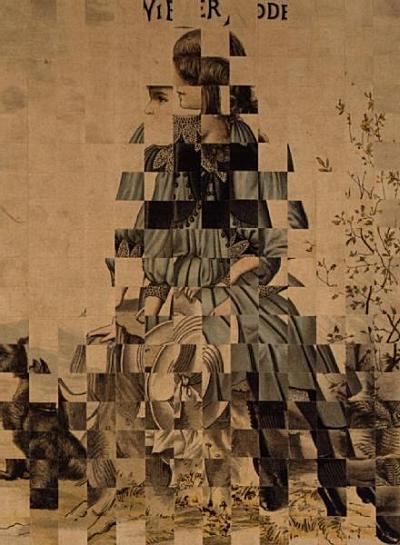
Girl with a dog
1963
Jirí Kolár
b. Sept. 24, 1914 Jirí Kolár:
His Life, Work and Cultural Significance to the Czech Republic
_______________________
Happy 12th anniversary In A Dark Time. Congratualtions and thanks Loren.
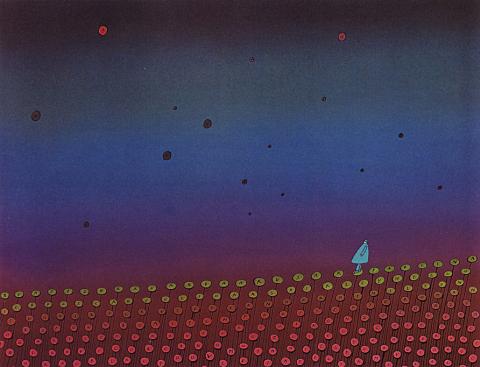
'The Art of Conversation'
Jean-Michel Folon
1972
50 Watts
1 2
via Biblioklept
_______________________
Seiobo There Below by László Krasznahorkai
and Music & Literature Issue 2
Andrea Scrima
quarterly conversation
(....)
After the publication in English translation of Satantango, The Melancholy of Resistance, and War and War—which together with Seiobo There Below constitute an important cross-section of Krasznahorkai’s prodigious literary output—his bleak outlook on a human history bent on calamity has become legendary. ...
(....)
... with Seiobo There Below, he has set himself the task of writing about something that is essentially impossible to formulate in language. We are no longer accustomed to using words like “illumination,” “transcendence,” or “epiphany”; indeed, in our secularized Western world they can sound embarrassing and even ridiculous. Yet his is a language that flows in liquid state, eddying around obstructions to form vortices of swelling thought in which the consistency can suddenly gel, become viscous—and all at once, the writing embodies precisely what it describes as these endless, spell-binding sentences gradually alter our perception and prepare us for a brief glimmer of something outside ourselves, something that can perhaps explain us to ourselves.
...(more)
_______________________
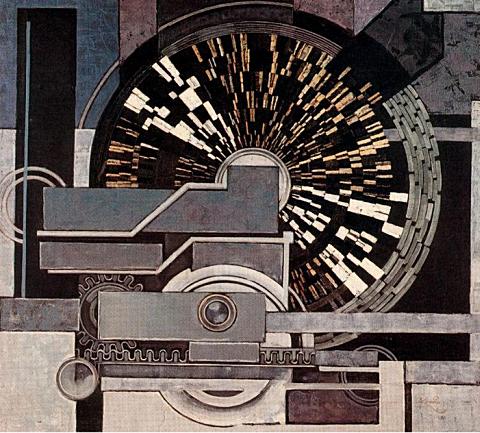
music
1936
František Kupka
b. Sep. 23, 1871
_______________________
Difficult Loves
Italo Calvino
Translated by
William Weaver and Archibald Colquhoun
and Peggy Wright
full text
Animal Woods
Italo Calvino
On days of Fascist round-ups the woods might have been a fairground. Off the paths, among the bushes and trees, there was a constant passage of families urging along a cow or a calf, and old women leading a goat on a rope, and girls with a goose under one arm. Some of them were even escaping with their rabbits.
Wherever one went, the thicker the chestnut woods, the more one ran into heavy-bellied bulls and tinkling cows, which were finding it difficult to move on those rocky slopes. Best off were the goats, but perhaps the happiest were the mules, which just this once could move without carrying a burden and go cropping leaves along the alleys. The pigs went rooting about in the ground, pricking their snouts all over with chestnut husks; the chickens roosted in the trees and frightened the squirrels; the rabbits, which after centuries of cages had forgotten how to dig themselves lairs, took refuge in hollow tree trunks, where they were sometimes bitten by squirrels.
That morning a peasant named Giuà Dei Fichi was gathering fuel in a remote corner of the woods. He knew nothing about what was happening in the village, for he had left the evening before, intending to gather mushrooms in the morning, and had slept in the middle of the woods in a hut used, in autumn, for drying chestnuts.
So as he was chopping a dead tree trunk with a hatchet he was surprised to hear a vague tinkling of bells far and near through the woods. .....
_______________________
A Genealogy of Instinct
Steve Barbaro
conjunctions
“You pay a price for being a child of the New World.”
—Saul Bellow
There were few realms in which he was a novice, that Saro, let alone the sphere of self-fashioning. Exceedingly fleshy yet with terrific agility, this first cousin of my mother flaunted the same billowy paunch that would come to be called, by its own bearer, The Tomb of, Not (as he always made clear) the Ubiquitous Anchovy, but of the Eternal Engraulis Encrasicolus. And from within that same center of gravity Saro brandished forearms like two looted Vitruvian columns, those trunk-like appendages pushing, say, dough-topped pan after dough-topped pan into the backs of ovens, with the spots gathering on the nearby walls and floors and countertops simply being the sweat droplets Saro’s forehead all the time threw off and pumped out and threw off.
He was a kind of pioneer, this Saro, the first of my Sicilian kin to come to America, and to Virginia. From the one picture my mother keeps in the living room, Saro’s eyes seem a strangely arctic kind of blue, a color not unlike that of the mentholated cough drops I would come to spend years fondling in a warehouse right outside of Chicago, that most solemn modern hub; yet a certain force of antiquity was revealed by the way the kid-Saro, just out of reach of the shadows of an almond tree or in the brush beside some caper bushes, would all of sudden stoop low, mouthing Romanum Imperium morto o non morto or some such bricolage and then standing back up to wield, unfailingly, millennially aged coinage.
...(more)an excerpt from The Incident at Natural Bridge, Steve Barbaro's novel-in-progress.
Steve Barbaro poems 1 2 3 4
_______________________
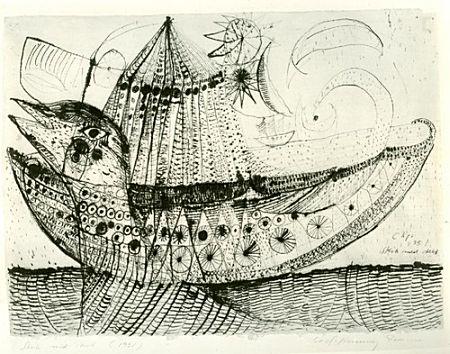
Ship With Tent
1951
Carl-Henning Pedersen
b. Sept. 23, 1913
_______________________
Embodied Cognition’s Philosophical Roots
Andrew Iliadis
Ethical Technology
(....)
Thinking cognition in terms of technology is proving useful, and cognitive scientists as well as philosophers are beginning to circumvent the impasse of the mind-body problem via the theory of embodied cognition. Embodied cognition is the idea that cognition is predicated on not only our bodies but, in a more radical branch, on the technologies that we use. Here, the body is no longer seen as peripheral but rather as constitutive of the very process of thinking. Embodied cognition is thinking in action.
The quest to explain embodied cognition is really another example of philosophy getting it right the first time. There have been many figures in the history of philosophy who argued for a radical break from the idea that our minds were something that reflected or represented nature. They intuitively sought to explain the mind in terms of the body and in terms of its action, eventually leading to profound ideas on the essence of technology.
Today, cognitive scientists are turning to some of these unexpected philosophical theories and sources, and this has allowed for a productive dust-off and redeployment of some useful concepts that once remained hidden, deeply buried in either branch’s past....(more)
_______________________

Mirror-Shadow XV1
1985
Louise Nevelson
b. Sept. 23, 1899
 1937
Hans Hartung
(21 September 1904 – 7 December 1989)
_______________________
from Squarings
Seamus Heaney
agni
Sand-bed, they said. And gravel-bed. Before
I knew river shallows or river pleasures
I knew the ore of longing in those words.
The places I go back to have not failed
But will not last. Waist-deep in cow-parsley
I re-enter the swim, riding or quelling
The very currents memory is composed of,
Everything accumulated ever
As I took squarings from the tops of bridges
Or the banks of self at evening.
Lick of fear. Sweet transience. Flirt and splash.
Crumpled flow the sky-dipped willows trailed in.
(....)
For certain ones what was written may come true:
They shall live on in the distance
At the mouths of rivers.
For our ones, no. They will re-enter
Dryness that was heaven on earth to them,
Happy to eat the scones baked out of clay.
For some, perhaps, the delta’s reed beds
And cold bright-footed seabirds always wheeling.
For our ones, snuff
And hob-soot and the heat off ashes.
And a judge who comes between them and the sun
In a pillar of radiant house dust. ...(more)
_______________________
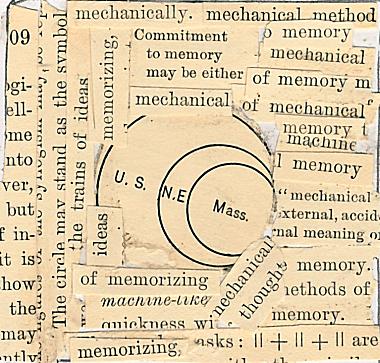
from Long Trains of Thought (numbers 10-17)
Nick Piombino
AlteredScale
_______________________
from To the Secret [pdf]
Franck André Jamme
(tr. Norma
Cole)
(....)
12
the spider webs
enlacing the hands
the real
the principle
sitting at first
in ambush
then suddenly falls
on us
the silence
the root of the ritual
13
the enigmas
that you evoke
before the boundless opaque expanse
and this is nearly no use
seeing that season after season
you feel more and more
that solutions are elsewhere
or moreover don’t exist
the singing gestures
of the beginning
the wild ones
who perhaps have breathed on you
everything you know
or not far
...(more)
AlteredScale.com 4
_______________________
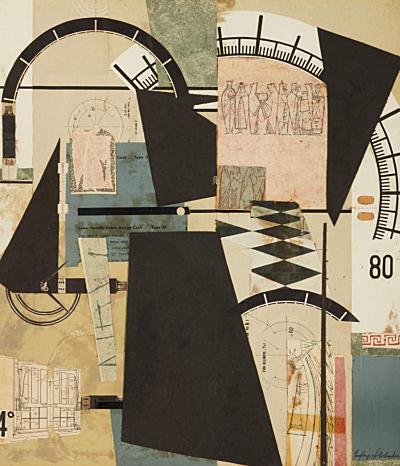
Holy Land
1947
Esphyr Slobodkina
(September 22, 1908 - July 21, 2002)
_______________________
This Is My Room
Tomasz Rózycki
Translated from Polish by Mira Rosenthal
words without borders
(....)
Columbus was wrong. There’s no earth whatsoever
after sunset, a boat sails into the dead
of night and goes on and on forever:
you discover islands, christen all dream worlds
with names, and your crew fast asleep in Never
Never Land grows younger and younger instead
in the Freudian hemisphere. If they return,
Circe will change them once again into men.
...(more)
_______________________

Hans Hartung
1953

A Voyage to the Island of the Articoles
Alexander Alexeieff's illustrations for
Voyage au Pays des Articoles by Maurois, 1927
from the collection of Richard Sica
50 Watts
_______________________
“Many ideas turn into lifelong disfigurements”
From Thomas Bernhard's novel Frost
excerpt posted at Biblioklept
“Many ideas turn into lifelong disfigurements,” he said. The ideas often surprised one years later, but sooner or later they would always make the one who had had them look ridiculous. The ideas came from a place they never left. They would always remain there, in that place: it was the place of dreams. “The idea doesn’t exist that can be expunged or expunge itself. The idea is actual, and remains so.” Last night, he had been thinking about pain. “Pain doesn’t exist. A necessary illusion,” he said. Pain wasn’t pain, not in the way a cow was a cow. “The word ‘pain’ directs the attention of a feeling toward a feeling. Pain is overplus. But the illusion of it is real.” Accordingly, pain both was and was not. “But there is no pain,” he said. “Just as there is no happiness. Found an architecture on pain.” All thoughts and images were as involuntary as the concepts: chemistry, physics, geometry. “You have to understand these concepts to know something. To know everything.” Philosophy didn’t take you a single step nearer. “Nothing is progressive, but nothing is less progressive than philosophy. Progress is tripe. Impossible.” The observations of mathematics were foundational. “Oh, yes,” he said, “in mathematics everything’s child’s play.” And just like so-called child’s play, mathematics could finish you. “If you’ve crossed the border, and you suddenly no longer get the joke, and see what the world’s about, don’t see what anything’s about anymore. Everything’s just the imagining of pain....(more)
_______________________
Oana Avasilichioaei: On Beauty
lemon hound(....)
The crux and difficulty of the point seen, in a suspended fragile moment, with perfect clarity.
Intricate finely chiseled
held up to public domain.
Beauty specific
in light of status and use
in light of customs and kinship.
Yet lived and searched for in the world, in the social, in the outer not just the inner, in the transaction, in the fleeting, in the ordinary, in the now, in the next. Specifically and irrefutably of the matter while transcending the matter.
Nothingness is beautiful
Many try (and fail) to wright this.
...(more)
Oana Avasilichioaei at PennSound12 or 20 questions: with Oana Avasilichioaei
rob mclennan
Oana Avasilichioaei’s beasts
Stephen Collis
Oana Avasilichioaei’s We, Beasts (Wolsak & Wynn 2012) proposes a linguistic wilderness where her last book—Feria (Wolsak & Wynn 2008)—laid out a “poempark.” The wilderness we are returned to here is the one formed by language on the edge of wildernesses long gone—the liminal space of fairy and folk tale, where we stare back at the animals we try to deceive ourselves we no longer are. Voice drifts into voice, language into and out of language—words are birdcall in dense forest where a strange chimera called the Wolfbat (who joins other “characters”—the Tyrant, Dawn, a “maiden”) inhabits a “culture of creatures” and “pastures the pulsing of nontales.”
There is much to say about this book—its play with folk tale tropes and traditions, the wisps of narrative that dissolve into thickets of opaque language, its staging of gender and sexuality, reeking with hybridity, multiplicity and an animal desire to, well, fuck any and all comers. There’s also the book’s fascinating “beastly taxonomies” that graph aspects of a surreal world surrounding and sometimes intersecting with the book in hand, the interruption of a book-within-the-book (“Spelles”), complete with different paper stock, and the way the book’s serial poems entangle and interrupt each other (somewhat reminiscent, structurally, of Kevin Davies’s The Golden Age of Paraphernalia).
But what I want to comment on, briefly, here is Oana’s “we”—...(more)
_______________________
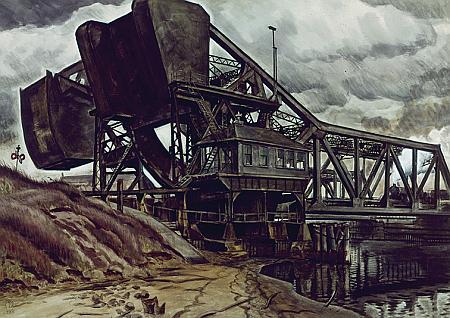
Black Iron
Charles Burchfield
1935
Realism
Tom Clark
illustrations - Charles Burchfield
The smashed weirdness of the raving cadenzas of God
Takes over all of a sudden
In our time. It speaks through the voices of talk show moderators.
It tells us in a ringing anthem, like heavenly hosts uplifted,
That the rhapsody of the pastoral is out to lunch.
...(more)
_______________________

photo - mw
_______________________
AZ661748
Jari Jä rvelä
Translated by Hildi Hawkins
A short story from Novelli palaa! Matkanovelleja ('The short story returns! Travel stories', edited by Katja Kettu and Aki Salmela
books from Finland
(....)
Dad has a whole squared exercise book full of places. The Arc de Triomphe and the Empire State Building and the Taj Mahal. The Colosseum and the Suez Canal and the Egyptian pyramids and the statue of the Little Mermaid in Copenhagen.
He keeps his exercise book in the shed under the wasps’ nest, so that Mum won’t notice. Other people keep a bottle of vodka among the logs, Dad keeps his dream trips.
In the middle of the summer Dad picked blueberries and Arctic brambles and heated the sauna every other night. The Arctic bramble is the best berry in the world. It took time to heat the sauna. Dad used his knife to cut pictures out of dolphins and churches and mountains and castles from travel brochures, and stuck them in his exercise book with a glue stick.
It was Dad’s loon book.
...(more)
_______________________
Gdansk Fever
John M. Edwards
identity theory
(....)
I let myself disappear from this elementally charmed preserved city, with no solution to the pyroclastic revisionism buzzing in my brain like New York City cab-colored bumble bees bumping into each other, whose drivers swore at each other in different Indo-European languages.
It was almost as if I had revised myself out of one troubling sociopolitical epoch into another one potentially even worse, while never having really been there in the first place, rubbed out by the eraser of Polish poet Czecheslau Milos:
“They shrieked in the tongues of dwarves!”
...(more)
_______________________
 Shaker Interior
Sabbathday Lake, Maine
1971
George Tice
60 years of Photography
Nailya Alexander Gallery
via Andrew Abb
1 2 3
_______________________
In My Own Recognizance
Ronald Sukenick
(1932-2004)
electronic book review
I personally am enamored of the traditional Canon but not interested in repeating it. My ways of avoiding it are through the practice of certain mental gymnastics, or, rarely, through the use of constrictive form as with the Oulipo group whom I consider creative cousins.
Mental gymnastics: ways of blocking the already formulated in pursuing the unformulated.
I try to write in that mental space of 30 seconds where the past claws at the future to produce what we call the present. That helps me get past the premeditated.
Remember the future. That helps me avoid the prefabricated.
(....)
In any case, the idea of fiction is the wrong idea. In the sense of making something up. Thinking through narrative is more like it. I think through things situationally employing a grammar of event.
It provides resolutions in the same way that dream supplies resolutions: by engaging the feelings involved rather than the rational. Or rather, both. Because feelings have their logic.
Because experience is mostly stories.
Because stories are based in experience, not necessarily the author's but always partly so.
Beause writing it is part of the experience of it.
Because fiction is experience plus desire.
...(more)
_______________________
 Aspen Grove
1969
George Tice
_______________________
Poems: John Berger
Words II
The tongue
is the spine’s first leaf
forests of language surround it
Like a mole
the tongue
burrows through the earth of speech
Like a bird
the tongue
flies in arcs of the written word
The tongue is feathered and alone in its mouth
...(more)
_______________________

Zina Hill's Barber Shop
from Moulinette
one of the Lost Villages
photo - mw
_______________________
All LinkedIn with Nowhere to Go
Ann Friedman
The Baffler No. 23
In a jobs economy that has become something of a grim joke, nothing seems quite so bleak as the digital job seeker’s all-but-obligatory LinkedIn account. In the decade since the site launched publicly with a mission “to connect the world’s professionals to make them more productive and successful,” the glorified résumé-distribution service has become an essential stop for the professionally dissatisfied masses. The networking site burrows its way into users’ inboxes with updates spinning the gossamer dream of successful and frictionless advancement up the career ladder. Just add one crucial contact who’s only a few degrees removed from you (users are the perpetual Kevin Bacons in this party game), or update your skill set in a more market-friendly fashion, and one of the site’s 187 million or so users will pluck you from a stalled career and offer professional redemption. LinkedIn promises to harness everything that’s great about a digital economy that so far has done more to limit than expand the professional prospects of its user-citizens.
In reality, though, the job seeker tends to experience the insular world of LinkedIn connectivity as an irksome ritual of digital badgering. ...
(....)
This frenetic networking-by-vague-association has bred a mordant skepticism among some users of the site. Scott Monty, head of social media for the Ford Motor Company, includes a disclaimer in the first line of his LinkedIn bio that, in any other context, would be a hilarious redundancy: “Note: I make connections only with people whom I have met.” It’s an Escher staircase masquerading as a career ladder.
...(more)
_______________________
Of critical theory
Reynard Seifert
htmlgiant
Forty years ago Harold Rosenberg said “art in our time cannot escape having a political content and moral implications. Criticism that is unaware of this is fatally poverty-stricken.” Today you can look for critical theory behind cans of soup at the supermarket. You can find it in your apartment, or in your home. Maybe even your pool, if you have a pool. Your cat can teach you critical theory. Your dog is chasing a squirrel. There’s a lesson here somewhere, everywhere. Even at the corner store. Not in the trees. The trees can’t tell you about critical theory, but the wind can. You don’t have to have a sense of humor to know it’s raining a lot. Look around. Better yet, look at yourself. Harder. Look harder and deeper at yourself. And see that you are just an it. Critical theory is the space between things. There are books entirely on this lack of space. More books all the time more books on theory. Eat. But you don’t need to read the books. You just need to pay attention to them. ...(more)

photo - mw
_______________________
The Mind’s Games
William Carlos Williams
If a man can say of his life or
any moment of his life, There is
nothing more to be desired! his state
becomes like that told in the famous
double sonnet--but without the
sonnet’s restrictions. Let him go look
at the river flowing or the bank
of late flowers, there will be one
small fly still among the petals
in whose gauzy wings raised above
its back a rainbow shines. The world
to him is radiant and even the fact
of poverty is wholly without despair.
So it seems until these rouse
to him pictures of the systematically
starved--for a purpose, at the mind’s
proposal. What good then the
light winged fly, the flower or
the river--too foul to drink of or
even to bathe in? The 90 story building
beyond the ocean that a rocket
will span for destruction in a matter
of minutes but will not
bring him, in a century, food or
relief of any sort from his suffering.
The world too much with us? Rot!
the world is not half enough with us--
the rot of a potato with
a healthy skin, a rot that is
never revealed till we are about to
eat--and it revolts us. Beauty?
Beauty should make us paupers,
should blind us, rob us--for it
does not feed the sufferer but makes
his suffering a fly-blown putrescence
and ourselves decay--unless
the ecstasy be general.
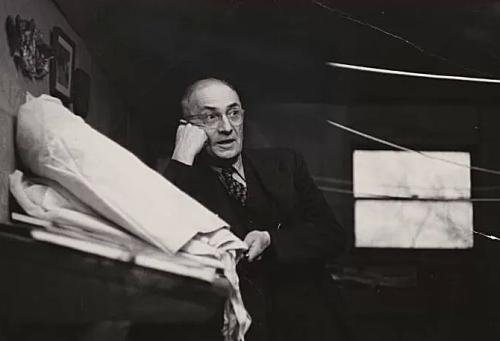
William Carlos Williams
b. September 17, 1883
Photograph by Constantin Joffe
_______________________
There Is No Need For An End
Odette Gregory
(....)
What if our grand questions about the world ended with, “I don’t know.” Would that harm us? Does not knowing have to be accompanied by feelings of panicked desperation? Must we think ourselves inert if we do not have answers? What if we started with I don’t know? What will we do with Palestine and Israel? I don’t know. What will we do about hunger and miseducation? I don’t know. How will we live peaceably, without war and conflict? I don’t know. Is not I don’t know a better place to start than our usual conclusions, ideals and ideas? How is referencing what has already happened and what has already been thought (and what has not worked) a correct way to address how to move forward from right now? Perhaps in the ground of not knowing we have more possibility to create something new. We can put aside our predispositions and knowledge and simply give matters our attention. Indeed this may take more time. Or it may take no time at all. But the lunches, dinners, breakfasts, meetings, flights and arrangements accompanying our usual fast way of gathering together, sometimes for several days or weeks, to swiftly arrive at answers also takes time and over the course of years has substantially little to show as far as solving our grand world problems. It is obvious we don’t know, by the overall state of global affairs, so saying we don’t ought not be too challenging.
Let us all stop pretending. The urge to be right and definitive is ingrained into ourselves. We adore confidence and conclusions, especially if it is accompanied by a new technology and somebody says the word science. We write long reports about everything we know and every state of being we think we should have including bullet points for things we can do to be better. But rarely do we write about the world as it actually exists right now and how we have been utterly incapable of doing anything fundamentally different in it. This is not pessimism. Saying we are optimistic and having positive thoughts is not a substitute for critical inquiry. We are not going to smile ourselves into a better world. And just because we are smiling does not mean we care.
...(more)
The Lifeboat Foundation
_______________________
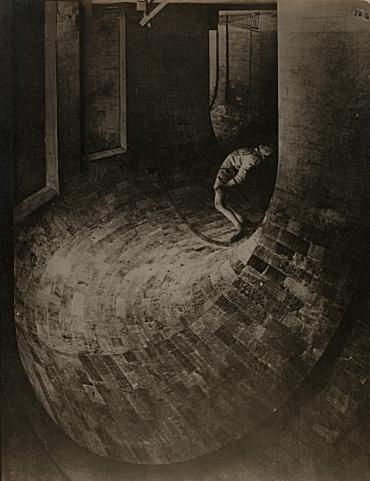
Le simulateur
Dora Maar
1936
_______________________
Three Poems
Nyla Matuk
Canadian Notes & Queries
Capitalism
Nyla Matuk
(....)
The CN Tower casts its ex-cathedra shadow by day,
recently suited with LED lights, red and purple.
With the moxy of a junior vampire,
they stroke the shaft with abandon;
that is, aggregating the infrared of the city
and taking possession even as markets drain
the sweet sad drainage of abandoned wives.
A motive pure as sunrise, sure as sunset.
Watch the flick of green and greedy gold on a deerfly:
a glittering buzz we still don’t understand.
...(more)
Sumptuary Laws
Nyla Matuk
amazon
via rob mclennan
Hot Button:
A Review of Nyla Matuk's Sumptuary Laws
Stewart Cole
Nyla Matuk at Representative Poetry Online
rpo.library.utoronto.ca/poets/matuk-nyla
12 or 20 (second series) questions with Nyla Matuk
rob mclennan
Return To Metcalfe Street
Nyla Matuk
walrus
Notes on a Middle Aged Poet
Nyla Matuk
hazlitt
_______________________
Joy Arises, Rules Fall Apart
Thoughts for the Second Anniversary of Occupy Wall Street
Rebecca Solnit
(....)
Those who dismiss these moments because of their flaws need to look harder at what joy and hope shine out of them and what real changes have, historically, emerged because of them, even if not always directly or in the most obvious or recognizable ways. Change is rarely as simple as dominos. Sometimes, it’s as complex as chaos theory and as slow as evolution. Even things that seem to happen suddenly turn out to be flowers that emerge from plants with deep roots in the past or sometimes from long-dormant seeds.
It’s important to ask not only what those moments produced in the long run but what they were in their heyday. If people find themselves living in a world in which some hopes are realized, some joys are incandescent, and some boundaries between individuals and groups are lowered, even for an hour or a day or -- in the case of Occupy Wall Street -- several months, that matters.
The old left imagined that victory would, when it came, be total and permanent, which is practically the same as saying that victory was and is impossible and will never come. It is, in fact, more than possible. It is something that participants have tasted many times and that we carry with us in many ways, however flawed and fleeting. We regularly taste failure, too. Most of the time, the two come mixed and mingled. And every now and then, the possibilities explode.
...(more)
_______________________
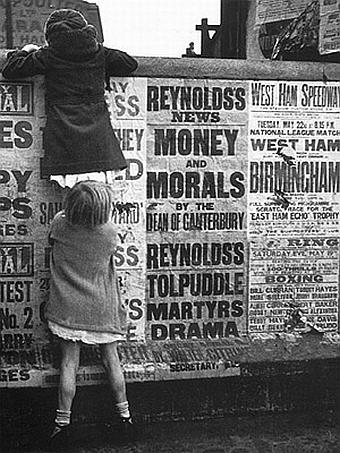
Money and Morals
1934
Dora Maar
1907-1997
_______________________
5 Years Later, We've Learned Nothing From the Financial Crisis
Why haven't we destroyed the idea that destroyed the world?
James Kwak
(....)
Why are we behaving as if the past five years didn’t happen? Ideas don’t invent and propagate themselves. They are promoted by economic and political interests. Financial deregulation became the Washington consensus in the first place for a few basic reasons. Business interests dominated the Republican Party. Democrats, in order to compete for campaign cash, had to cultivate Wall Street. Community bankers and real estate agents wanted to sell houses to everyone. Lobbyists became power brokers inside the Beltway. Regulators who cared about their self-interest realized that the long-term money lay in being friendly to industry. And everyone wanted growth and low interest rates.
Fast forward to 2013—skipping over that bit of unpleasantness in 2008—and little has changed. Republicans live in a fantasy world where regulation is always bad and deregulation is always good. Democrats scramble to make nice with hedge fund managers and investment bankers. Everyone wants the housing market to recover. The long-term money is still in industry and lobbying. And everyone—especially Democrats—wants growth and jobs more than ever.
Financial stability has no lobby. ...(more)
_______________________
A new digital ecology is evolving, and humans are being left behind
George Dvorsky
(....)
“Even though each trading algorithm/robot is out to gain a profit at the expense of any other, and hence act as a predator, any algorithm which is trading has a market impact and hence can become noticeable to other algorithms,” said Neil Johnson, a professor of physics at the College of Arts and Sciences at the University of Miami (UM) and lead author of the new study. “So although they are all predators, some can then become the prey of other algorithms depending on the conditions. Just like animal predators can also fall prey to each other.”
When there’s a normal combination of prey and predators, he says, everything is in balance. But once predators are introduced that are too fast, they create extreme events.
"What we see with the new ultrafast computer algorithms is predatory trading,” he says. “In this case, the predator acts before the prey even knows it's there."
Johnson describes this new ecology as one consisting of mobs of ultrafast bots that frequently overwhelm the system. When events last less than a second, the financial world transitions to a new one inhabited by packs of aggressively trading algorithms.
...(more)
_______________________

photo - mw
_______________________
The Dead Rhetoric of War
Chris Hedges
(....)
The myth of war, as each generation discovers over the corpses of its young and the looting of its national treasury by war profiteers, is a lie. War is no longer able to divert Americans from the economic and political decay that is rapidly turning the nation into a corporate oligarchy, a nation where “the consent of the governed” is a cruel joke. War cannot hide what we have become. War has made us a nation that openly tortures and holds people indefinitely in our archipelago of offshore penal colonies. War has unleashed death squads—known as special operations forces—to assassinate our enemies around the globe, even American citizens. War has seen us terrorize whole populations, including populations with which we are not officially at war, with armed drones that circle night and day above mud-walled villages in Pakistan, Yemen and Somalia as well as Iraq and Afghanistan. War has shredded, in the name of national security, our most basic civil liberties. War has turned us into the most spied-upon, monitored, eavesdropped and photographed population in human history. War has seen our most courageous dissidents and whistle-blowers—those who warned us of the crimes of war and empire, from Chelsea (formerly Bradley) Manning to Edward Snowden—become persecuted political prisoners or the hunted. War has made a few very rich, as it always does, as our schools, libraries and firehouses are closed in the name of fiscal austerity, basic social service programs for children and the elderly are shut down, cities such as Detroit declare bankruptcy, and chronic underemployment and unemployment hover at 15 percent, perhaps 20. No one knows the truth anymore about America. The vast Potemkin village we have become, the monstrous lie that is America, includes the willful manipulation of financial and official statistics from Wall Street and Washington.
We are slowly awakening, after years on a drunken bender, to the awful pain of sobriety and the unpleasant glare of daylight. ...(more)

photo - mw
_______________________
Surveillance and Society
Vol 11, No 1/2 (2013)
Surveillance Futures
Edited by Kirstie Ball, Clive Norris and David Murakami Wood.
Introduction
(....)
Surveillance studies has played a vital role in exposing the emergence of surveillance societies over decades, but this has now reached a critical pitch. Surveillance is now global, not just in the sense of it being in every country, but in the sense of it being a part of everyday life for all the world’s people, whether they know it or not. Surveillance practices do not just, as Katja Aas has stated, form the ‘contours of the global polity’ (2011: 332), but increasingly determine the shape of the economy and the contents of culture. It is no longer enough, we would argue, to consider examples of surveillance, and to note their nuances and differences, important though this is, especially in places where little attention has been paid to surveillance so far. Surveillance studies needs more serious attention to the political economy of surveillance, not just in terms of studies of particular corporate actors, or the growing ‘surveillance economy’ but the way in which surveillance works in and for government (in the broadest sense) at this global scale.
We are left with a situation that seems confusing to cursory analysis based in the assumptions of older disciplinary analysis: what exactly does it mean when US corporations build Chinese Internet surveillance systems and Chinese companies are considered as exemplary for the British government considering online censorship? When Facebook works actively with both the US and Pakistani states to gather personal data and censor posts respectively? When the NSA works with Google in China to deal with issue around Chinese state censorship whilst at the same time maintaining active collection systems with the assent of the Chinese state? There is a complex global surveillant assemblage which is not amenable to simple descriptions of many former theoretical approaches (Murakami Wood, 2013).
What the different practices of information management and surveillance at all levels share is a combination of the normalization of surveillance as a life-practice (i.e. something that everyone can and should do for their own protection and enjoyment, that is involved in all work and activities) with the sharing of the products of surveillance through organizations and systems that allow their use by a corporate-state nexus that seeks both to increase flows that create opportunities for exploitation and profit and at the same time reduce the uncertainties and risks that come from bad circulations - in other words what Foucault (2007) termed ‘security’. That this constitutes a kind of emerging neoliberal global government should be clear if one considers ‘security’ in this sense as the basic function of government. It does matter that the shape of this global government, pervasive and networked as it is, is not the ideal- typical model of government of political theories past.
For surveillance studies, what is important at this juncture is to recognize that there is a need to shift to an
integrated political economic analysis of surveillance that is not bound by assumptions about either the
nature of the state or of capital. ...
_______________________
Studies in Material Thinking
Volume 01:1
At the Intersection of Poesis and Praxis: Material thinking provocations
The aim of this inaugural volume of Studies in Material Thinking was to generate momentum and collaborative exchange around issues of art and design process, materiality and research practice, in particular, the paradigms by which we understand artistic and design research. It is a collection of diverse position statements and provocations about the concept of material thinking from researchers working in a variety of disciplines. The materiality of different disciplinary practices coming together in new relationships opens the way for us all to re-imagine our approaches to practice, theory and methodology.
Volume 09
Inside Making
Making is both a knowledge-based and a knowledge-generating process. This volume of papers explores the significance of making as a mode of thinking and an impulse toward invention. Accounts of creative practice, form-making and pedagogy reveal the insights of reflective practicing artists, enquiring researchers and discerning teachers who recognize the importance of understanding the physical and material aspects of making knowledge. This volume is co-edited by Nancy de Freitas, Auckland University of Technology, New Zealand and Eva Lutnæs, Oslo University College, Norway.
_______________________
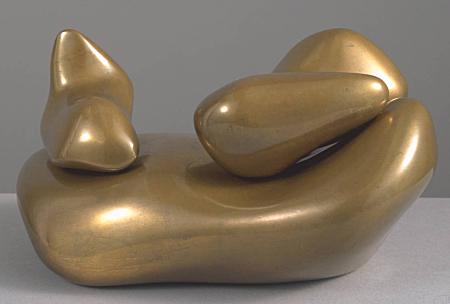
Sculpture to be Lost in the Forest
1932
Jean Arp
b. Sept. 16, 1886
_______________________
Mysteries of the Speaking Body
The Real Through Line symposium, Melbourne, April 2013
Fiona Hile
jacket2
In an English translation of a French transcription of a lecture delivered in 1973, Jacques Lacan proposes his ground-changing formulation: ‘Mathematization alone reaches a real’. For Lacan, what this means is that what we thought was fantasy and what we thought was knowledge are now entwined. Reality is not what we thought it was. Or rather, it is whatever we think it is. The one thing it isn’t, however, is real. This is, in lots of different ways, very good news for a one-day symposium that proposes to bring together ‘leading scholars and practitioners interested in the poetry of the real world.’ As Lacan remarked, ‘Man believes he creates – he believes, believes, believes, he creates, creates, creates.’ The symposium, held in April 2013, was the latest in a series of scholarly collaborations from Jessica Wilkinson (RMIT) and Ali Alizadeh (Monash). The proceedings of the symposium will soon appear in Axon, an online journal published out of the University of Canberra.
_______________________
Mysticpoetics: Writing the alchemical self in Brenda Hillman's poetry
Jennifer Phelps
jacket2
Brenda Hillman’s poetry circumnavigates around the overarching interest of spirit, matter, and everything in between. Even though Hillman’s work is often uncategorizable, she works within a vein that combines traditional lyric as well as more experimental forms. In addition, she incorporates various theologies and esoteric philosophies in her writing. Hillman has said of herself, “I think of myself as a mystic in a practical way.”Hillman blends cultural references, nature, and the spiritual with an open lyric form that leaves room for mystical experiences to occur on the page. Hillman’s poetry can be read as enacting an alchemical process where spirit is turned into matter and matter into spirit.
(....)
Through experiments with form, Hillman disrupts assumptions of what poetry is. She creates a sense of bafflement by juxtaposing ordinary events in her poems with the imaginative and mysterious. Fanny Howe calls this a poetics of “bewilderment,” where one composes in a state of wonder, awe, and disorientation. A poetics of bewilderment can also be understood within the terms of what psychoanalyst Carl G. Jung (1875–1961) describes as a way of uncovering true uniqueness: “If I want to understand an individual human being, I must lay aside all scientific knowledge of the average man and discard all theories in order to adopt a completely new and unprejudiced attitude.” Hillman has a similar theory of composition: “The place where we make poetry is outside any familiar state. Poetry sort of makes us stranger so we can wake up in a place where everything hangs off the edges, creating itself.”
...(more)
_______________________

photo - mw
_______________________
In periods of social crisis, photography as art can seem an inhuman escape. It is so often apparently distant from the specific catastrophes in the day’s news. Think of Stieglitz making, during the worst years of the Depression, his coldly beautiful views of New York City from the heights of the Sheraton Hotel — or of Ansel Adams photographing in the Sierras as the worst of World War II was being fought in Europe.
In response to juxtapositions like these there are critics who have asked for “concerned photography,” by which they mean photography that deals directly with social ills. Few photographers themselves have, however, supported the use of the adjective “concerned” as a way of distinguishing one artist from another; they know firsthand that all art is the product of concern. They believe as a consequence that it has social utility — it is designed to give us courage. Society is endangered to the extent that any of us loses faith in meaning, in consequence. Art that can convincingly speak through form for significance bears upon the problem of nihilism and is socially constructive. Restated, photography as art does address evil, but it does so broadly as it works to convince us of life’s value; the darkness that art combats is the ultimate one, the conclusion that life is without worth and finally better off ended. Which is to say that art addresses an inner struggle whereas journalism more often reports on the outward consequences of it. Perhaps this is what William Carlos Williams meant when he wrote that “It is difficult/to get the news from poems/yet men die miserably every day/for lack/of what is found there.” We have all had the sad opportunity to watch that. And though poems and pictures cannot by themselves save anyone — only people who care for each other face to face have a chance to do that — they can strengthen our resolve to agree to life.
- Robert Adams, from Photographing Evil collected In Defense of Traditional Values
posted by James Luckett at consumptive
|






































